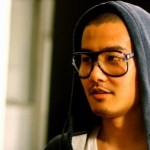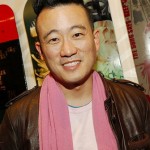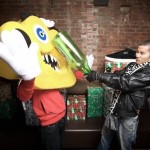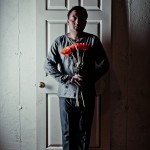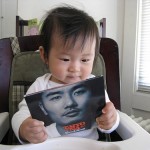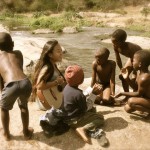
Above: A Taiyo Na scrapbook. Shown here are Regie Cabico, Taiyo Na, Taiyo Na’s youngest fan, Ishle Yi Park, Beau Sia and Taiyo Na fighting a giant yellow _____ .
As the Sulu Series came to an end on September 19, 2010 to a packed house at The Bowery Poetry Club in New York, I sat down with Sulu’s artistic director, Taiyo Na, to try to understand what five years of Asian and Pacific Islander performing arts meant to him and to our community. Below is a recap of our conversation, which I hope will inspire other cities (like The Sulu Series in New York, Sulu DC and Family Style in Philadelphia, among others) to gather and find platforms for our unique voices.
* * *
How did The Sulu Series begin in New York?
Two things really contributed to the formation of Sulu: Hurricane Katrina and the Boston APIA Spoken Word and Poetry Summit in 2005. After the Boston Summit there was a lot of good energy after a really great Summit. Regie [Cabico] felt like there needed to be a hub in New York City for Asian American artists. It was also because the Asian American Writers Workshop at the time felt like a less community-friendly space. Before that, the Asian American Writers Workshop was kind of that hub, so there was that factor. But then when Hurricane Katrina hit, it was like “Wow!” you know? It was a pivotal moment in the country of course, but also for a lot of us here because when they were covering Katrina we knew that there were a lot of Asian Americans down there in Louisiana and Mississippi and their stories weren’t being told and their needs weren’t being attended to. Sure, everybody was affected in that region. Everybody deserves the attention. But we wanted to do something in particular with the Asian American community to say, “You know, there’s a lot of Vietnamese folks there and they need help.” So we put together this benefit for those folks and the money went to the this group in Biloxi, Mississippi. That benefit kind of brought a lot of Asian American artists and organizations together and since then, we carried on Sulu. Regie was living in Williamsburg at the time and had a connection at Galapagos Arts Space in Williamsburg, Brooklyn. And they were like, “Hey, we have these Tuesday nights open, do you want to take it once a month?” and I’m like, “Okay.”
Was it just you and Regie [Cabico] then?
No, no, no, it was a bunch of us. [DJ] Boo was there. There were other artists, too. Terry Park and Chaz Koba, Hanalei . . . and a bunch of others. Even at the Katrina benefit, I became one of the main sort of cultural connectors—people who have the contacts with the artists and brought the artists together. It just kind of became this natural thing for me to do the monthly Sulu curating too after that. We did, I think, the thing at Galapagos for maybe a year or so and then, things weren’t really workin’ out there. The location was Williamsburg and not Manhattan and it was hard for folks to get to and you know, the vibe was different. So when the Bowery Poetry Club . . . I forgot what happened. But, we did an event here. We did like a special Sulu at the Bowery Poetry Club. It had to do with triple A.S. (Asian American Studies Conference). It was happening one year in New York and it went really well, so we were like, “Oh, well let’s just have it here.” Beau Sia has a good relationship with Bob Holman and it just all organically came about. Bowery Poetry Club became the new home and it’s been our gracious home ever since (for the last three years or so).
What do you see as the state of affairs for AAPI poetry, specifically in New York but in the rest of the country, also?
The APA poetry community here . . . I mean, I’m not per se an expert, but I think with Kundiman, it’s great. What they do here is just phenomenal. What Joseph Legaspi, Sarah Gambito and Ron Villanueva and Pat Rosal and all those folks have done to build that organization up to a retreat that can have like 20-some poets every year to help nurture their talents, to have a monthly reading series, is great. I think they’re a little bit more of an older crowd, more of like an academic crowd, but that’s fine, there’s that. But I think spoken word per se if we were to kind of split poetry up into those two camps—more academic poetry and then spoken word poetry—spoken word poetry is real healthy. It’s more mainstream, so there’s less of kind of the underground stuff, you know? It’s bigger and more popular than ever.
So, you feel positive about AAPI poetry?
I feel positive mostly. The Asian American Writers Workshop is the place. It’s turned around. They have a new director there, Ken Chen, who, in the last couple years, has really revitalized the space and he’s been very supportive for all kinds of younger and new artists.
Top three AAPI poets for you, in your heart, whose careers you follow. The ones you feel are the most innovative and most important to watch. Who should we be watching?
See, now that’s a couple questions there! Now, are you talking about like my favorite poets who I constantly learn from?
Let’s say the three AAPI poets who have crossed this stage who inspire you most?
Ok, so my personal top three, as in people who are friends and also mentors, people I love and admire and learned so much from constantly are Beau Sia, Ishle Yi Park and Regie Cabico.
What makes them different?
I could speak volumes about their greatness, but in their own unique way, they each have a really special gift. They really sincerely care about the truth and humanity of what their artwork is there to serve. I could go on and on, but that’s part of it.
Who are the rookies?
My favorite rookies, umm, that’s a good question . . . Simone! [Laughing] I don’t even feel like I’m really qualified to answer that question because there are just like, so many up-and-coming, great poets. People that have come through Sulu as of recent that have really touched me? There are a few, like Elijah Kuan Wong, Tiana Nobile, Rachelle Cruz, Vinh Hua . . . they’ve all performed at Sulu and they are all in their mid- to late 20’s. They’re great.
How do you identify? Would you identify first as a community organizer? Artist? Curator?
As an artist and someone who does artsy things. Even what I do at Sulu is an extension of me as an artist. You know, the title of Artistic Director was all just put on by Regie, Hanalei or whomever. What community organizers do, and I don’t consider myself a community organizer because I have friends who are and I really admire the work they do. And what they do is organize the community to make laws pass and to have protests and you know, all these things that create small systematic changes. Me, as an artist, I’m culturally organizing. I could call myself a cultural organizer.
That’s beautiful! I’ve never heard anybody say that. I like that title.
But you know, that’s what we as artists do. We organize people not to pass laws and protests—and we could!—we could play a role in those struggles, but what we mainly do is organize shows, we organize albums and projects and event productions. That’s what we do. And we organize media and art.
But, that’s important, too, if not equally so . . .
Sure! It all plays a part in the play of life. Absolutely.
What do you think people will remember about The Sulu Series?
I’m sure there are academics and scholars who could break this sh-t down all day . . .
We don’t need them to tell our stories!
[Laughs] But, um, me . . . Sulu is just a place that we needed at the time in New York City. We needed—young, Asian Americans needed—a hub, needed a base, a place where once a month you can depend on people from, you know, way-faring souls from all over the country to maybe be there, you know what I mean? And to have young artists here, to be here, to connect and to feel like they’re not alone. You know like, many Asian American artists feel like they’re like the only one around. But, you know, Sulu is like that little hub where you don’t have to explain yourself and you can just be yourself and you can just be, and try out new work and have an awesome, rock star show that’s so quality and it’s not pretending to be anything for anybody. I think this little place is like no pretense. Pretense isn’t allowed here. It’s different from some talent shows that are trying to impress people. And they have an important job to impress people and you know, get money and sponsorship. But, that’s not really like our goal here. Our goal here is just to make sure the artists that exist and that they have a space where they can call home, meet, have fun and drink. You know, some of the memorable nights are nights where people don’t remember them!
* * *
